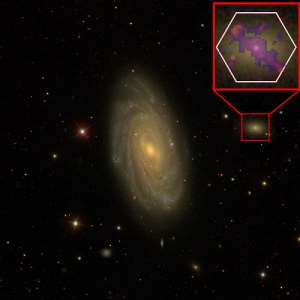
Scientists have solved a cosmic mystery by finding evidence that supermassive black holes prevent stars forming in some smaller galaxies.
These giant black holes are over a million times more massive than the sun and sit in the centre of galaxies sending out powerful winds that quench the star-making process. Astronomers previously thought they had no influence on the formation of stars in dwarf galaxies but a new study from the University of Portsmouth has proved their role in the process.
The results, presented today at a meeting of the American Astronomical Society, are particularly important because dwarf galaxies (those composed of up to 100 million to several billion stars) are far more numerous than bigger systems and what happens in these is likely to give a more typical picture of the evolution of galaxies.
“Dwarf galaxies outnumber larger galaxies like the Milky Way 50 to one,” says lead researcher Dr Samantha Penny, of the University’s Institute of Cosmology and Gravitation. “So if we want to tell the full story of galaxies, we need to understand how dwarf systems work.”
In any galaxy stars are born when clouds of gas collapse under the force of their own gravity. But stars don’t keep being born forever – at some point star formation in a galaxy shuts off. The reason for this differs in different galaxies but sometimes a supermassive black hole is the culprit.
Supermassive black holes can regulate their host galaxy’s ability to form new stars through a heating process. The black hole drives energy through powerful winds. When this wind hits the giant molecular clouds in which stars would form, it heats the gas, preventing its collapse into new stars.
Previous research has shown that this process can prevent star formation in larger galaxies containing hundreds of billions of stars – but it was believed a different process could be responsible for dwarf galaxies ceasing to produce stars. Scientists previously thought that the larger galaxies could have been interacting gravitationally with the dwarf systems and pulling the star-making gas away.
Data, however, showed the researchers that the dwarf galaxies under observation were still accumulating gas which should re-start star formation in a red, dead galaxy but wasn’t. This led the team to the supermassive black hole discovery.
Dr Penny said: “Our results are important for astronomy because they potentially impact how we understand galaxy evolution. Supermassive black holes weren’t thought to influence dwarf systems but we’ve shown that isn’t the case. This may well have a big influence on future research as simulations of galaxy formation don’t usually include the heating effect of supermassive black holes in low-mass galaxies, including the dwarf systems we have examined in this work.”
The team of international scientists used data from the Sloan Digital Sky Survey (SDSS), which has a telescope based in New Mexico, to make their observations. Using SDSS’s Mapping Nearby Galaxies at Apache Point Observatory (MaNGA) survey, they were able to map the processes acting on the dwarf galaxies through the star systems’ heated gas, which could be detected. The heated gas revealed the presence of a central supermassive black hole, or active galactic nucleus (AGN), and through MaNGA the team were able to observe the effect that the AGN had on their host dwarf galaxies.

The attached image shows one of the dwarf galaxies (in red box) that the team found to contain a supermassive black hole. Its red colour shows it is no longer forming new stars. For size comparison, the dwarf galaxy is superimposed next to large galaxy similar to the Milky Way. The dwarf galaxy contains about 3 billion stars, while the spiral galaxy contains about 300 billion.
The inset (top right) shows a larger image of the dwarf galaxy overlain with some of the MaNGA data for this galaxy, which revealed the winds from the supermassive black hole. Darker purple regions show gas heated by winds from the galaxy's central black hole.
Notes
Sloan Digital Sky Survey is a large, international collaboration, made up of hundreds of scientists from around the world. MaNGA is one of three current projects being undertaken using the 2.5 metre telescope at Apache Point Observatory in New Mexico (the telescope mirror has a diameter of 2.5 metres).
By Samantha Penny (Institute of Cosmology and Gravitation, University of Portsmouth) and the SDSS collaboration




 Akufo-Addo commissions Phase II of Kaleo solar power plant
Akufo-Addo commissions Phase II of Kaleo solar power plant
 NDC panics over Bawumia’s visit to Pope Francis
NDC panics over Bawumia’s visit to Pope Francis
 EC blasts Mahama over “false” claims on recruitment of Returning Officers
EC blasts Mahama over “false” claims on recruitment of Returning Officers
 Lands Minister gives ultimatum to Future Global Resources to revamp Prestea/Bogo...
Lands Minister gives ultimatum to Future Global Resources to revamp Prestea/Bogo...
 Wa Naa appeals to Akufo-Addo to audit state lands in Wa
Wa Naa appeals to Akufo-Addo to audit state lands in Wa
 Prof Opoku-Agyemang misunderstood Bawumia’s ‘driver mate’ analogy – Miracles Abo...
Prof Opoku-Agyemang misunderstood Bawumia’s ‘driver mate’ analogy – Miracles Abo...
 EU confident Ghana will not sign Anti-LGBTQI Bill
EU confident Ghana will not sign Anti-LGBTQI Bill
 Suspend implementation of Planting for Food and Jobs for 2024 - Stakeholders
Suspend implementation of Planting for Food and Jobs for 2024 - Stakeholders
 Tema West Municipal Assembly gets Ghana's First Female Aircraft Marshaller as ne...
Tema West Municipal Assembly gets Ghana's First Female Aircraft Marshaller as ne...
 Dumsor is affecting us double, release timetable – Disability Federation to ECG
Dumsor is affecting us double, release timetable – Disability Federation to ECG
